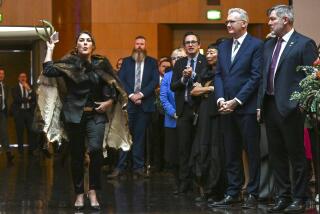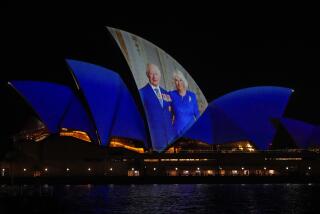Pope Defends Aborigines’ Land, Culture Rights
- Share via
ALICE SPRINGS, Australia — Flying twice across the breadth of Australia on Saturday, in the longest and most taxing day of his current pilgrimage, Pope John Paul II forcefully defended the rights of the country’s aborigines, who welcomed him here in the heart of their outback homeland with ancient ceremonial dances, clacking boomerangs and native instruments.
Although the pontiff’s theme during a two-hour, open-air prayer meeting here was a strong and controversial plea for the aborigines’ rights to their traditional lands and culture, the message was all but overshadowed by his own and the natives’ enthusiasm for touching each other.
John Paul threw his organizers and their schedule into disarray by impulsively spending more than half an hour in what the natives call a “dream walk” along a serpentine path through their ranks in Alice Spring’s Blatherskite Park.
He stood patiently and with obvious pleasure while hundreds kissed his papal ring and hundreds more shook his hand or held up their children for papal kisses and affectionate pats on their tousled and mostly dirt-smeared heads.
Didgeridoos, ‘Amazing Grace’
Singers and dancers from 10 tribal groups, some of them bare-breasted women, performed intricate corroboree (ceremonial dance) rituals beside the path as the Pope made his way slowly through the crowd of about 2,000 mostly native people.
In several groups, men beat a steady rhythm by clacking decorated boomerangs together, while others blew into long, tube-shaped wooden instruments called didgeridoos that droned eerily as women, accompanying the men, made a steady buzzing sound with their humming. One of the groups sang the 1960s American civil rights song “We Shall Overcome,” while a native pop group called the Mills Sisters performed U.S. country and western numbers, capping their performance with “Amazing Grace.”
But the meeting turned serious, arousing the hostility of some Alice Springs white residents, when the pontiff spoke of aborigine land rights, a controversial topic in the land where the native people have lived for 40,000 or more years and the white settlers for only 200.
The Pope dismissed out of hand the “legal fiction” adopted by the original settlers that “this land was ‘terra nullius’ -- nobody’s country.” He quoted an early Australian clergyman as pleading “for the rights of the aboriginal inhabitants to keep the traditional lands on which their whole society depended” and added, “The Church still supports you today.”
Land Claims Disputed
Although the country’s 160,000 aborigines benefited a decade ago from national land rights legislation, many of their claims are being disputed, although even aborigine activists concede that some of the claims, such as those in downtown Sydney, have no chance of success.
Many of the tribal homelands, such as those in this outback area of central Australia, are bleak desert areas of little interest to Australians of European extraction, but oil and mineral deposits in some of them have inspired controversy and disputes.
In his speech, John Paul noted that in some areas of dispute, the aborigines might have to give way. “Certainly, what has been done cannot be undone,” he said. “But what can now be done to remedy the deeds of yesterday must not be put off till tomorrow.”
But he made clear that he stood firmly on the side of native rights.
“Let it not be said that the fair and equitable recognition of aboriginal rights to land is discrimination (against whites),” he said. “To call for the acknowledgment of the land rights of people who have never surrendered those rights is not discrimination.”
‘Violence Can’t Heal’
He asked that any new agreements concerning the rights of the aborigines “be implemented without causing new injustices” and said that “past hurts cannot be healed by violence, nor are present injustices removed by resentment.”
John Paul sipped frequently from a glass of water to ward off the effects of the 90-degree heat in Alice Springs and the torrid and humid 95-degree weather at his previous stop in Darwin two hours before.
For a brief period following his arrival in Alice Springs his special Mercedes-Benz papal vehicle -- sometimes called the Popemobile -- broke down, and he shifted to an air-conditioned bus to wait while technicians got the glass-topped vehicle started.
In the course of what was his longest day, the 12th, of his two-week, 30,000-mile tour of the South Pacific and Indian Ocean, John Paul flew from Melbourne on the south coast to subtropical Darwin on the north coast, then to the country’s dead center at Alice Springs, and finally to Adelaide, back on the south coast. The total distance was about 3,500 miles, and he spent almost eight hours airborne.
Radio Talks With Children
While flying over the outback en route to Darwin, John Paul held two-way radio conversations with children in a remote settlement who study, courtesy of the Katherine School of the Air, entirely by radio, and with doctors, nurses and dentists of the country’s pioneering Royal Flying Doctor Service who take care of people in remote outback areas.
In Adelaide on Saturday night, he was met by thousands of people who lined the route of his motorcade holding lighted candles celebrating the Advent of Christmas.
More to Read
Sign up for Essential California
The most important California stories and recommendations in your inbox every morning.
You may occasionally receive promotional content from the Los Angeles Times.













